How We Restore Your Attic
Although they won’t be able to chew through insulation, the pests can easily tear it. The insulation material can be used as more than bedding. After all, the animals who are chewing at your attic’s ceilings will find a place for themselves in those holes, and then leave behind their own contaminants, such as urine and stool. You’ll also lose money because these areas have less insulation integrity. Here are the steps we use to restore an attic.

Scoop out Larger Feces Clumps
The first step of an attic restoration is to remove large amounts of feces left behind by insects. We use a long-handled tool for removing the feces off the ceilings and walls. If the droppings are dry or stuck on hard surfaces we will soak them in water, and then use a wire brush for scraping them off.
AAAC technicians use a tool with an extendable handle that allows them to climb up onto your roof to reach high places where squirrels and raccoons often leave their feces. Technicians may have to remove large amounts of droppings from the rafters or eaves in order to safely vacuum it out.

Vacuum Small Feces
Next is to clean out the attic of small rodent feces pellets by vacuuming. This is the only way to remove tiny pellets of feces found in attics from rats, mice, and other rodents. AAAC uses a specialized machine with a large enough hose that can reach the furthest point in your attic. It has an extra-long, powerful vacuum tube, high-speed suction, and HEPA filter that removes animal hair and droppings. AAAC also uses a special brush attachment to reach tight areas such as corners or near the roofline.
AAAC uses UV light to locate small feces hidden in attics. Any surface that has feces left behind by animals like bats, rats, or raccoons will look like black spots when exposed to UV light.

Air Duct Cleaning & Repair
AAAC Wildlife Control offers duct repair and restoration services. This includes removing animal hair, droppings and urine from the ductwork. AAAC uses a specially designed tool to clean the inside of ducts and remove any debris. After cleaning the ducts, we can spray disinfectant to kill any bacteria or viruses left behind by squirrels, bats, raccoons or rats.

Decontaminate the Attic
After removing the critters, the most important step in an attic restoration is decontamination. This is an essential part of the job. You want to make sure your family remains safe from possible microbial pathogens.
AAAC Wildlife Removal uses a UV light to identify areas that may have been infested with rodent droppings. The technicians will then apply a disinfectant spray and clean up any animal feces.
AAAC Wildlife Removal will fog up the attic using a fine mist in order to kill microorganisms from animal feces. The electric atomizer sprayer creates a cloud of microscopic droplets that cannot be seen by the human eye. Droplets that evaporate leave behind a chemical residue that is toxic to microorganisms like bacteria, viruses, and algae.
The attic restoration process also requires that the attic be dried. This is because moisture can encourage mold growth if it isn’t removed. AAAC might use a dehumidifier in order to dry out the insulation and wood attic. This helps to prevent mold growth in the attic space during re-insulation.

Full Attic Insulation Replacement
This part of the restoration work is completed by removing old insulation and then installing a brand new one. You must remove the insulation carefully in order to avoid damaging adjacent areas or making a mess. Insulation is typically wrapped around joists and rafters. It’s important to not pull too hard, as you could damage the wood structures in your attic.
Insulation also often contains mold spores and other potentially dangerous materials, which can be released into the air when the insulation is removed. This is why our technicians wear masks – so they don’t breathe in any particles that might make their way into the air ducts.
After removing the insulation, technicians will then place new ones. The insulation must be cut so it fits snugly around the joists and rafters. It is possible to leave some pieces behind by cutting things too close. Technicians also use masking tape and a sealer during installation to hold everything in place.
What is full attic restoration?
Attic restoration involves restoring the functionality and appearance of an attic. Attic restoration consists of insulation, decontamination, and waste removal.
When attics get dirty and dusty due to animal droppings, accumulated dirt, or ice accumulation, their ability to insulate is often reduced. This loss of insulation allows more energy to be lost through your home than if the insulation had been left intact. The decontamination process starts with using fans in interior spaces where moisture has accumulated.
How do you disinfect an attic?
To disinfect an attic, you must first remove old insulation then clean the attic with a disinfectant or an ultraviolet sterilizer. To prevent reinfection, it is also important to clean all surfaces that have been in contact with contaminated material.
To ensure that the process is safe and efficient, insulation must be removed. Attic restoration also involves the use of a powerful suction system to remove mold, bacteria, and other harmful materials from surfaces such as wood joists or rafters. Following this, a biocides washing is done. This not only kills the remaining mold but also leaves behind an antimicrobial substance that prevents further mold and mildew development. The area is then sterilized using ultraviolet lights that are similar to those used at hospitals.
Total Attic Restoration Solutions
AAAC Wildlife Removal offers attic restoration services. We can clean out attics after wildlife removal. To restore the attic’s original condition, we clean out feces and remove any insulation that has been contaminated. AAAC Wildlife will soak any droppings on hard surfaces that have dried out or are stuck to the surface with water, and then use a wire brush for scraping them off. AAAC Pest Control technicians use a special tool with an extendable handle. This allows them to reach higher areas where squirrels or raccoons can often leave feces. If you need your air ducts completely decontaminated and cleaned of animal droppings and hair, we offer Air Duct Cleaning and Repair too. We can help you get your attic back.










